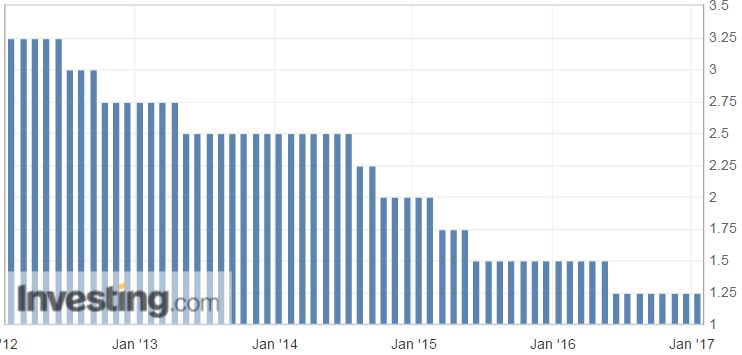The Bank of Korea (BoK) in its first monetary policy meeting of 2017 left its benchmark interest rate at record low of 1.25 percent, as markets widely expected. The board members defended this decision in the wake of global economic recovery, led by the US and some emerging market economies. Also, diminished global financial market volatility and rise in stock prices supported the central bank’s policy stance.
Looking ahead, the board judges that the global economic recovery will be affected by factors such as the directions of the new US government's economic policies, the pace of monetary policy normalization by the US Federal Reserve, and the movements toward spreading trade protectionism.
The Board sees the domestic economy as likely to continue its trend of moderate growth going forward, and forecasts a rate of GDP growth for this year in the mid-2 percent range. The trend of recovery in domestic demand activities is expected to be limited, due to deteriorations in economic sentiment for example, but exports will likely improve thanks chiefly to the global economic recovery.
Looking ahead the Board forecasts that consumer price inflation will gradually rise to near the 2 percent target level by around the middle of 2017, on the effects mainly of the increases in international oil prices, and that core inflation will maintain a level in the mid- to upper-1 percent range.
Lastly, the policy statement maintained that the central bank board members will conduct monetary policy so as to ensure that the recovery of economic growth continues and consumer price inflation approaches the target level over a medium-term horizon, while paying attention to financial stability.
The central bank in its forecast report said that the real GDP will increase by 2.5 percent in 2017 and by 2.8 percent in 2018. The Korean economy is expected to continue its moderate growth, driven by the improvement in exports and facilities investment thanks to the recovery of the major economies, while the growth in private consumption and construction investment are projected to slow down. In 2018 economic growth is projected to be 2.8 percent, supported by further improvements in exports and facilities investment as the global economy continues to recover.
Headline consumer prices are expected to rise by 1.8 percent in 2017, and by 1.9 percent in 2018. It is forecast that the pace of inflation will accelerate, in line with the higher level of oil prices compared to last year. And for 2018, inflation will increase about 0.1% as domestic economy gradually recovers. The current account balance is forecast to be around 81.0 billion dollars in 2017, and around 78.0 billion dollars in 2018.



 RBI Cuts Repo Rate to 5.25% as Inflation Cools and Growth Outlook Strengthens
RBI Cuts Repo Rate to 5.25% as Inflation Cools and Growth Outlook Strengthens  Hong Kong Cuts Base Rate as HKMA Follows U.S. Federal Reserve Move
Hong Kong Cuts Base Rate as HKMA Follows U.S. Federal Reserve Move  RBA Holds Rates but Warns of Rising Inflation Pressures
RBA Holds Rates but Warns of Rising Inflation Pressures  Oil Prices Climb on Venezuela Blockade, Russia Sanctions Fears, and Supply Risks
Oil Prices Climb on Venezuela Blockade, Russia Sanctions Fears, and Supply Risks  Austan Goolsbee Signals Potential for More Fed Rate Cuts as Inflation Shows Improvement
Austan Goolsbee Signals Potential for More Fed Rate Cuts as Inflation Shows Improvement  Bank of Korea Downplays Liquidity’s Role in Weak Won and Housing Price Surge
Bank of Korea Downplays Liquidity’s Role in Weak Won and Housing Price Surge  Chinese Robotaxi Stocks Rally as Tesla Boosts Autonomous Driving Optimism
Chinese Robotaxi Stocks Rally as Tesla Boosts Autonomous Driving Optimism  Kevin Hassett Says Inflation Is Below Target, Backs Trump’s Call for Rate Cuts
Kevin Hassett Says Inflation Is Below Target, Backs Trump’s Call for Rate Cuts  Asian Stocks Slide as AI Spending Fears and Global Central Bank Decisions Weigh on Markets
Asian Stocks Slide as AI Spending Fears and Global Central Bank Decisions Weigh on Markets 




























